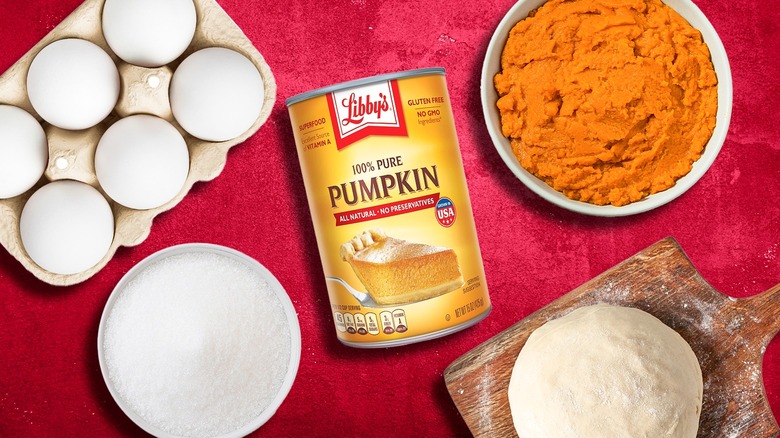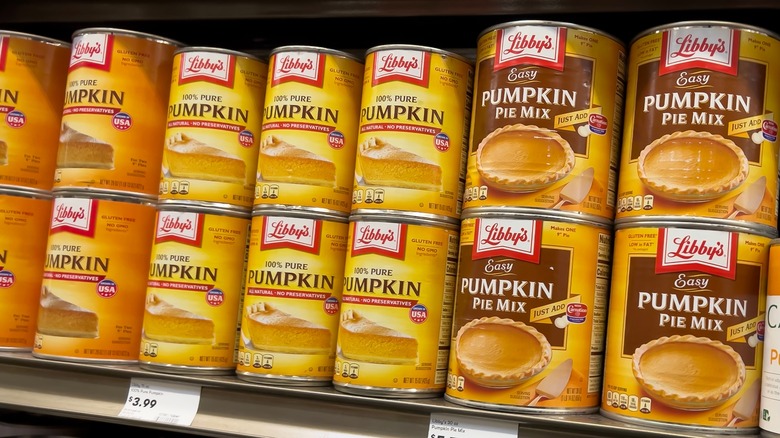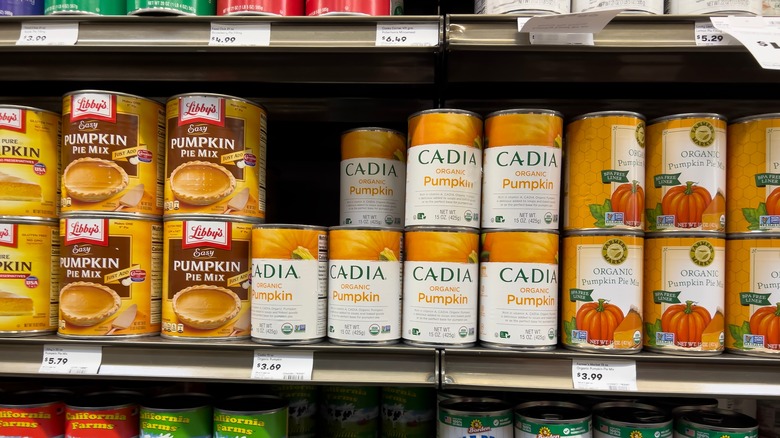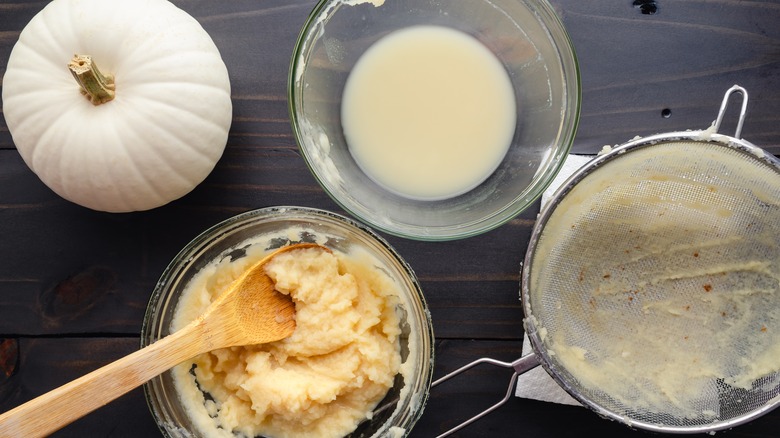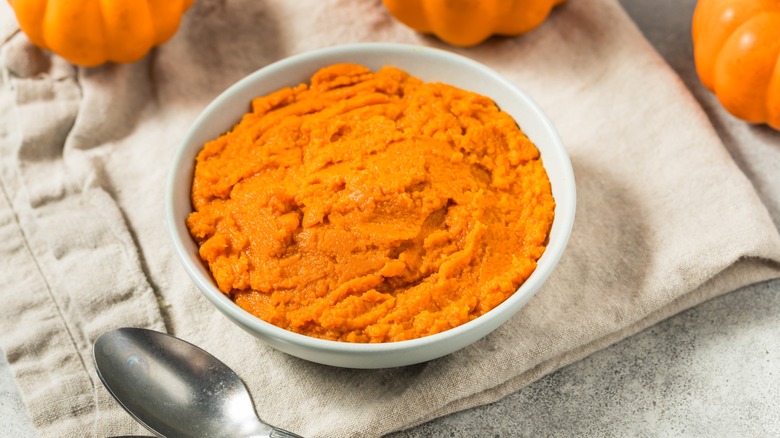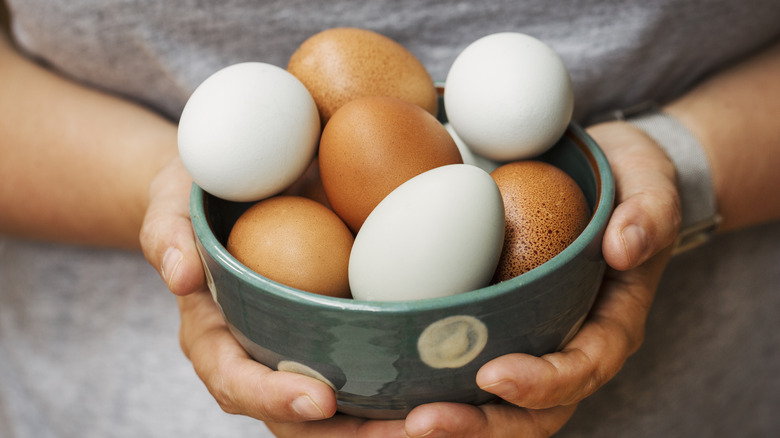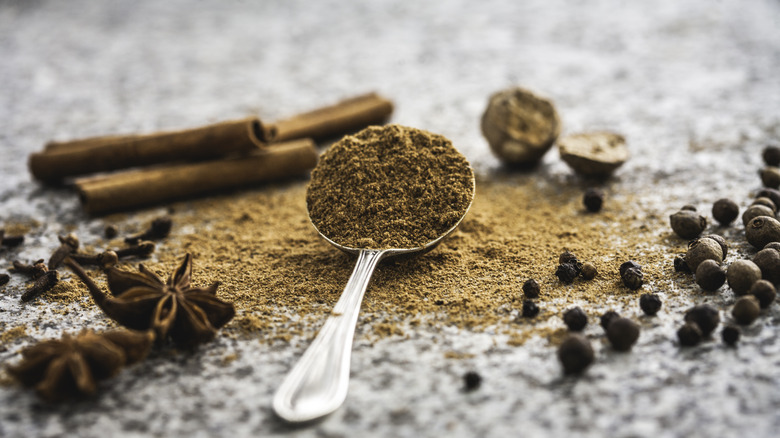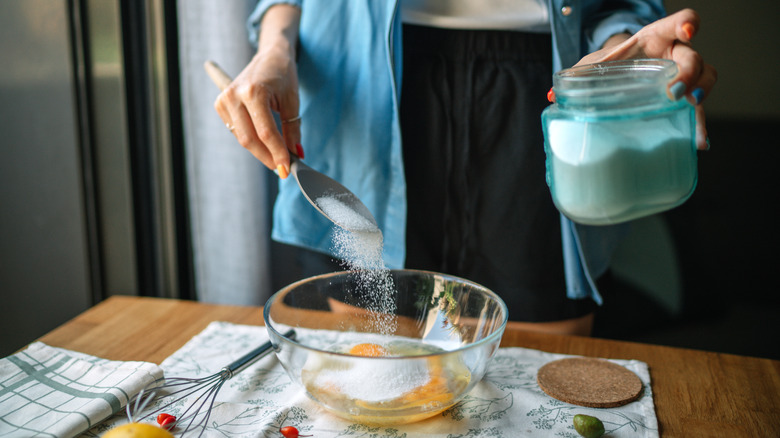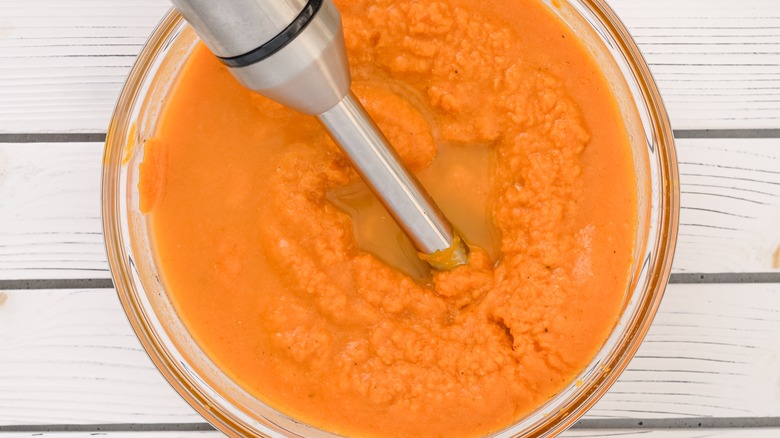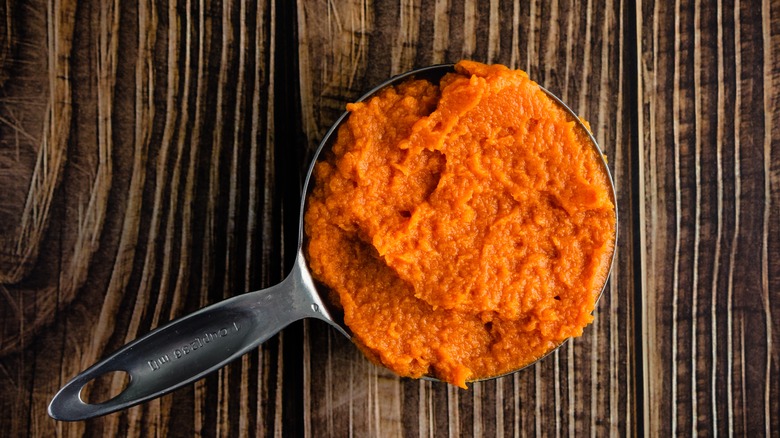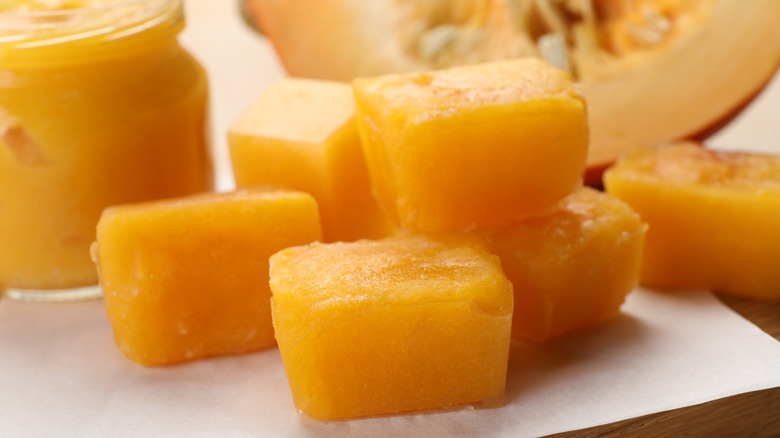11 Mistakes To Avoid When Baking With Canned Pumpkin
We may receive a commission on purchases made from links.
When the crisp air of fall rolls around, it's officially pumpkin season — a time when kitchens fill with the warm, spiced aroma of pumpkin treats. From fall-worthy pumpkin cinnamon rolls to seriously upgraded pumpkin bread, home bakers churn out the season's tastiest creations using one main ingredient: canned pumpkin. This convenient product is a low-calorie food packed with nutrients, including vitamins A (beta carotene), K, and E, plus copper, fiber, iron, magnesium, and potassium, making it both healthy and delicious.
Canned pumpkin offers the convenience of year-round baking without the hassle of cutting, cooking, pureeing, and straining fresh pumpkins. Even professional chefs and bakers — including myself — rely on this versatile ingredient in restaurant and bakery kitchens to save time without sacrificing quality. But while it might seem foolproof, baking with canned pumpkin comes with challenges. If not handled properly, it can lead to soggy textures, dense batters, and lackluster taste. Here are the most common mistakes to avoid when baking with canned pumpkin, so your fall-inspired treats are the best they can be.
1. Using pumpkin pie mix instead of puree
Canned pumpkin is typically stocked in the baking aisle of grocery stores, right next to canned pumpkin pie mix. While this makes perfect sense from a retailer's perspective, it's all too easy to grab the wrong can if you're in a hurry (trust me, I've been there). There's nothing worse than getting home ready to bake, only to realize you've bought pumpkin pie mix instead of pumpkin puree.
The difference between pumpkin pie mix and pumpkin puree is more than just a label. Pumpkin pie mix is pre-sweetened and spiced, containing added sugar and spices, while pumpkin puree is simply 100% pure pumpkin. Using pumpkin pie mix in a recipe that calls for puree can throw off your measurements and leave your baked goods tasting overly sweet or oddly spiced. While you could try adjusting the sugar and spice amounts in your recipe, it's best not to take the chance. Unless you're looking for a (mostly) ready-to-use filling for pumpkin pie, always check the label for "100% pure pumpkin."
2. Assuming all canned pumpkin brands are the same
Not all canned pumpkin brands are created equal, and assuming so can lead to inconsistent results in your baking. Variations can include everything from color, texture, moisture content, and flavor. Some brands offer a smoother puree, while others may be slightly gritty. Some may have a pool of liquid surrounding the puree when you open the lid, too. All these differences can affect the consistency and structure of your batter, leading to baked goods that are too dense, overly moist, or unevenly textured.
The flavor of canned pumpkin can vary between brands as well and impact the taste of your final product. Choosing a brand known for its quality and consistency — such as Libby's — can ensure that your pumpkin treats turn out great every time. Experimenting with different canned pumpkin brands may be necessary to determine your favorite. Knowing what works best for your recipes will help you meet your baking expectations.
3. Skipping the drain step
Until you find the canned pumpkin brand that works best in your recipes, you may come across one with a wetter puree than expected. When this happens, it's best to take the time to remove the excess moisture before baking with it to improve the texture and consistency of your baked goods.
There are several ways to rid your puree of extraneous liquid. One option is to cook it over low heat on the stovetop to evaporate the excess moisture. Another option is to place a fine-mesh strainer — like Fancymay's highly rated set — over a bowl to catch the liquid, then scoop the puree into the sieve and spread it evenly. Alternatively, lay a clean kitchen towel or several layers of paper towels on a large plate, spread the puree directly onto the paper towels, lightly dab the top with additional paper towels to absorb additional moisture, and let it sit for about 5 minutes. Once drained, your pumpkin puree is ready to be used as needed, from stirring it into waffle batter to blending it into a homemade pumpkin spice latte.
4. Adding too much pumpkin puree to your recipe
While adding extra amounts of pumpkin puree to your recipe may seem like a good way to boost the flavor and moisture, it can lead to disastrous results by throwing off the balance of ingredients. Pumpkin puree has a high moisture content, and using more than the recipe calls for can lead to dense, gummy, or wet baked goods that fail to rise properly. Worse yet, the extra moisture can also mute the flavors of spices and sweeteners — and what's the point of bland, underwhelming, not-sweet-enough fall treats?
To achieve the best results, it's best to stick to the exact amount of pumpkin called for in a recipe to maintain the intended texture and flavor. If you want a more robust pumpkin flavor, consider using additional spices — pumpkin spice, cinnamon, ginger, nutmeg, or cloves — or add a splash of pumpkin spice extract for an extra punch of autumn.
5. Using too many eggs
Most recipes that call for pumpkin puree also rely on eggs to achieve the perfect texture and structure. Eggs perform several important functions when baked with pumpkin puree. They help to bind the pumpkin puree with the other ingredients, and the proteins in eggs provide structure and stability, helping the baked good rise and set properly. Additionally, eggs add moisture to the batter to ensure a tender product, while the fat found in the yolk adds richness and flavor.
However, adding too many eggs when baking with canned pumpkin can make the final texture too cakey or too custardy and overpower the natural pumpkin taste. It's important to follow a recipe's egg measurements to maintain the perfect balance of moisture, structure, flavor, and texture. When used in the right proportions, eggs will make your pumpkin-based treats turn out exactly as they should, whether you're making cakes, muffins, pies, or bread.
6. Inadequately seasoning your canned pumpkin with spices
When people obsess over pumpkin treats, it's not just about the pumpkin — it's the cozy, nostalgic flavors and aroma of the spices used in them. Let's face it, pumpkin on its own is, well, kind of bland. That's why a generous amount of spices is the key to transforming dishes like a classic pumpkin pie from basic to outstanding.
Classic warm spices like cinnamon, nutmeg, allspice, ginger, and cloves are popular choices. But why stop there? For an unexpected twist that will delight your holiday guests, elevate your next pumpkin pie with Chinese five-spice, an Asian spice mix of cinnamon, cloves, fennel, star anise, and white pepper. Like being adventurous? Add a pinch or two of cumin or chili powder for a bold punch. And let's not forget salt — a pinch of salt amplifies every flavor to make your pumpkin creations irresistible.
7. Not adding enough sugar
When baking with canned pumpkin, skimping on sugar is a mistake that can leave your desserts tasting flat and subpar. While pumpkin is naturally sweet, it's pretty mild and earthy. Adding sugar injects vibrancy into the pumpkin to create a crave-able treat. But sugar doesn't just sweeten; it also enhances the pumpkin flavor and complements the spices. Additionally, without enough sugar, your pumpkin muffins or cakes will likely turn out too dense and bland.
Beyond granulated white sugar, natural sweeteners like maple syrup and honey can elevate your pumpkin desserts to new levels. Maple syrup adds a unique woody, caramel flavor, while honey brings a floral sweetness that softens pumpkin's earthiness. Even using a mix of different sweeteners can add multiple layers of flavor to your baked goods. So, the next time you whip up pumpkin bread for breakfast or dessert, try experimenting with different sweeteners and see what you think.
8. Overmixing your canned pumpkin
Overmixing canned pumpkin when baking can affect the texture and structure of your baked goods — and not in a good way. Overmixing can incorporate too much air into the batter, which can cause your baked goods to rise too much during baking and then collapse as they cool, leaving them dense and gummy. Additionally, overmixing leads to gluten development in recipes with flour, which can result in a tough and rubbery texture.
Another issue with overmixing is that it can break down the natural structure of canned pumpkin, which is already pureed and ready to use (aside from straining when needed). There's no need to mix or blend it on your own before using it. If you do, you can inadvertently break down the consistency of the pumpkin, causing it to turn slushy and watery, which will make the batter too loose and lead to uneven baking. Stick to mixing canned pumpkin only until it is fully incorporated with the other ingredients, and you'll achieve pro-baker results every time.
9. Overbaking or underbaking
Overbaking pumpkin-based treats can result in all sorts of problems. In pies, overcooked eggs can cause the filling to crack and develop a dense texture. In other baked goods, the natural sugars in pumpkin can over-caramelize, leading to a burnt taste and dense crumb. Knowing when to remove the baked goods from the oven can be tricky because pumpkins have a high moisture content, which can play tricks on you, as they can still feel moist even when fully baked. To avoid overbaking, use a timer and check for doneness a few minutes sooner than called for. Also, pay attention to visual cues like golden edges or a slight pulling away from the pan.
On the other hand, underbaking pumpkin baked goods can leave you with gooey centers and dense textures. Because canned pumpkin has a lot of moisture, underbaking can prevent the batter from setting properly. This is especially problematic for breads and muffins, and it's one of the biggest mistakes people make with pumpkin pie. To avoid underbaking, use a probe thermometer to remove the guesswork. For quick breads and muffins, the internal temperature should reach 200 degrees Fahrenheit.
To test whether your pumpkin pie is done baking, simply check that the custard filling has reached 180 degrees Fahrenheit. A little nudge for the jiggle test doesn't hurt either.
10. Substituting it for homemade pumpkin puree
Substituting canned pumpkin with homemade pumpkin puree might seem like a fantastic DIY project if you consider yourself a crafty baker. But before you start scooping that pumpkin, think twice — you could be setting yourself up for a baking blunder. Homemade pumpkin puree often turns out wetter and less consistent in texture compared to its canned cousin. This inconsistency can dilute flavors, increase the baking time, and affect how ingredients bind in recipes, leaving you with dense, soggy treats instead of that perfectly tender pumpkin bread you had in mind. So why risk it? Your goal is to bake the absolute best pumpkin bread, not to settle for mediocrity.
Unless your recipe specifically calls for homemade pumpkin puree, stick with canned. Recipes are typically tested with canned pumpkin, meaning that the precise moisture and texture the canned version provides are essential for success. Using homemade puree in a canned-based recipe can create unpredictable results that require adjustments in flour or baking time.
11. Not storing leftover canned pumpkin correctly
If you've baked with canned pumpkin before, you've likely faced the dilemma of leftover puree — often in those pesky, small amounts. As annoying as this might be, don't overlook its potential. Pumpkin is incredibly versatile and can be used in all sorts of ways. It's a terrific substitute for applesauce or bananas when baking muffins and quick breads, as it has similar moisture and sweetness levels. Beyond baking, leftover pumpkin can elevate savory dishes like soups, pasta sauces, and curries, or make a creamy addition to your favorite smoothie.
To keep your leftover pumpkin puree fresh, transfer it to an airtight container and store it in the fridge for up to four days, per the USDA. Watch for signs of spoilage, such as fuzzy mold or discoloration, and toss it if it's no longer fit for consumption. For longer storage, freeze the puree in small portions using an ice cube tray, then transfer the cubes to a resealable bag. This way, you can defrost what you need for your next recipe while avoiding waste.
